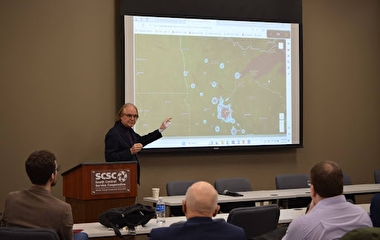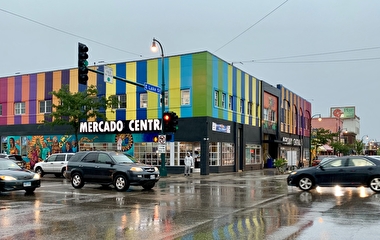A series of roundtable discussions hosted by the Humphrey School’s State and Local Policy Program (SLPP) investigated the policy impacts of new transportation technologies. The roundtables—held as part of SLPP’s work under the Transportation Policy and Economic Competitiveness Program—specifically explored the impacts of the digital infrastructure and self-driving vehicles.
Discussion topics included opportunities and obstacles for improved mobility and access for people who cannot drive, possible impacts of self-driving vehicles on urban form, and broader impacts of the digital infrastructure on the physical infrastructure. Participants included U of M faculty and research staff, key members of state and local governments, and interested citizens.
“One item that cut across all of these sessions was the potential for changing how we might define the ‘winners’ and ‘losers’ in the development of 21st century transportation,” says SLPP director Frank Douma.
disabilities. Photo: Shutterstock
Many technological developments, such as those related to self-driving vehicles, may offer benefits to currently underserved populations. People with disabilities will be able to “drive” the same vehicles as others, transit will become more flexible, and many trips may become unnecessary. But, Douma says, these advantages might not come about automatically—or easily.
“A clear example of this is the realization that just because a self-driving vehicle can transport a person that is physically unable to drive, it does not mean that the person will be able to easily enter and exit the vehicle, or easily interact with it, unless the vehicle has been specifically designed to meet the needs of these users,” Douma says.
Other equity-related discussion themes included:
- Economic impacts. The expansion of private ridesharing organizations such as Uber and Lyft has implications for taxi drivers and other transportation providers—and for lower-income neighborhoods. There may be a need to ensure continued transportation service to residents excluded from ridesharing services that require access to a smartphone and credit card.
- Technology and job class. New technologies can help individuals not only to improve their transportation options but also to do their jobs remotely. However, employees in the service sector and other positions that require a physical presence will benefit less from telework opportunities.
- Rural communities. Residents in rural areas may benefit less from new technologies than those in urban areas. Ridesharing and carsharing depend on higher-density neighborhoods to turn a profit, making lower-density rural communities less attractive markets. In addition, more limited broadband connectivity in rural areas means that residents have less access to telework, teleshopping, and telemedicine.
In spite of these questions and concerns, the roundtable discussions also highlighted the many ways new technologies could enhance equity. For example, they could allow aging rural residents to live in their homes longer, provide access to new economic opportunities for residents of low-income neighborhoods, and remove barriers for people with disabilities.
“However, without due attention from public officials, advocates, and this wide and varied group of stakeholders themselves, these benefits may not be realized,” Douma says. “[Although] self-driving vehicles and other developments of the digital economy are already legal…it is becoming increasingly clear that there is a role for public policy to ensure that the benefits are enjoyed as widely as possible.”




